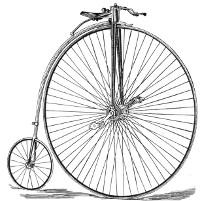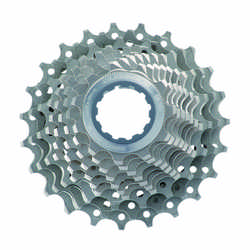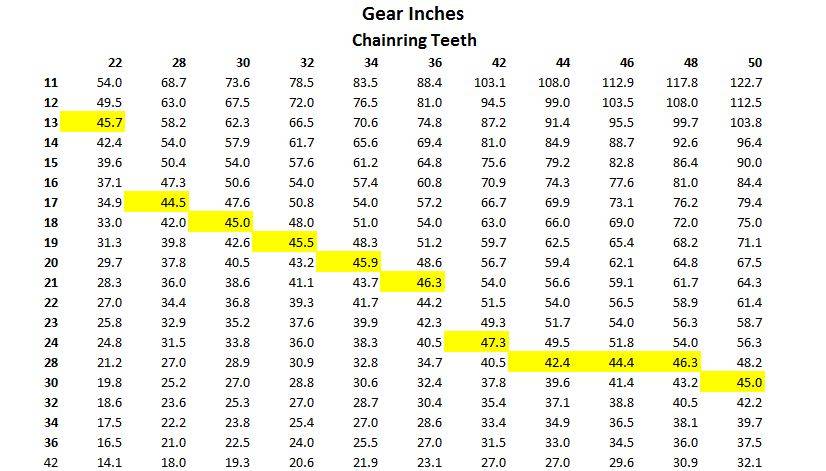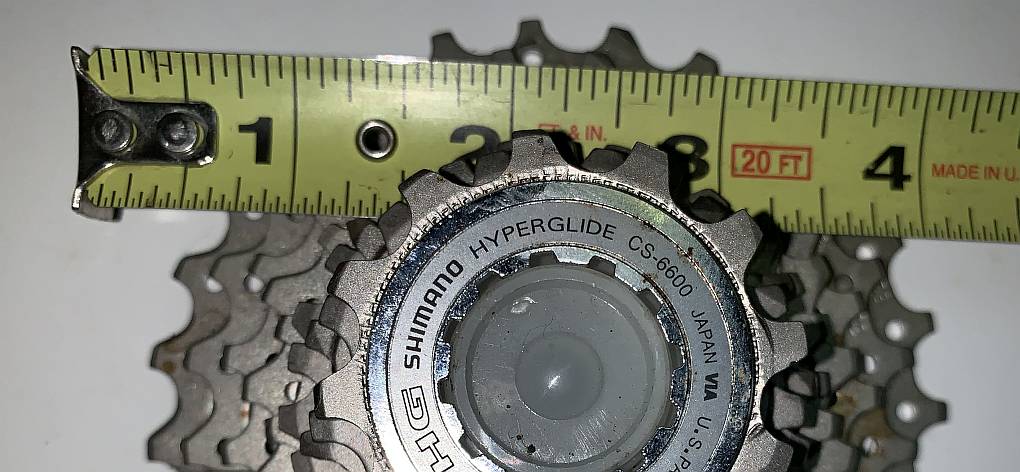Gear Inches, Cogs and Gears
What are gear inches and why do we care?

An Easy Way to Compare Ratios
Gear inches give you a way to calculate and compare gear ratios. The larger the gear inch number, the farther you will go with each rotation of the pedals with greater effort. Gear Inches are based on the old high-wheel bicycles. Imagine you are perched on a saddle over a 50 inch wheel. The pedal cranks are connected directly to the wheel. Each rotation of the crank is one rotation of the wheel. This means with a "gear" of 1 to 1 ratio (direct drive) the high-wheeler will have 1 x 50 or 50 gear inches. Pedaling one full rotation of the crank moves you forward fifty inches (the wheel diameter) times pi 157 inches, almost 4 meters.An Example
Now imagine pedaling on your modern bicycle. A standard 39 tooth inside chainring and a 21 tooth cog at the rear gives you 50 gear inches. That is 39/21 x 27 = 50. You will travel 50xpi, the same as the penny-farthing. The nominal diameter used is 27 inches for a 700c road bike. When we look at the wider tiers used for bicycle travel and gravel bikes the number is usually 28. For mountain bikes today, 29ers, the number is 29. What you are comparing is the gear ratio. I've included a link to an online calculator later in the article.
Why Traveling Cyclists Care
 Gear inches give you a way to compare the distance you travel with one revolution of the crank. Smaller gear inches mean more gear reduction. You can
pedal more easily, and you travel less distance with one revolution of the crank set. When you read a review of a touring bicycle or you are looking
at a new bike for your cycling adventures, you will want to know if the ratios are low enough to climb hill with a touring load. Many touring cyclists like that low gear to be about
20 gear inches. An old fashioned gear chart In contrast, larger gear inches mean less reduction and greater travel
for one rotation of the crank.
Gear inches give you a way to compare the distance you travel with one revolution of the crank. Smaller gear inches mean more gear reduction. You can
pedal more easily, and you travel less distance with one revolution of the crank set. When you read a review of a touring bicycle or you are looking
at a new bike for your cycling adventures, you will want to know if the ratios are low enough to climb hill with a touring load. Many touring cyclists like that low gear to be about
20 gear inches. An old fashioned gear chart In contrast, larger gear inches mean less reduction and greater travel
for one rotation of the crank.
Cogs for Loaded Climbing or Should You Buy That Bike
Now think about climbing hills with a fully loaded touring bicycle. What if you need a combination around 20 gear inches for loaded climbing? Say you have a Specialized AWOL they call an adventure bike. Mine came with a triple crank with 50/39/30 teeth and a 12-32 cassette. Take a look at the charts below. The lowest that bike will go is 25.3 gear inches. That isn't quite right since the 700cX42 tires are more like 28" in diameter. So we get 26.3 gear inches. That is a whopping 133% of the goal. Riding the GDMBR and even on the northern stretch of the Natchez Trace Parkway, I got down to 3.5mph on steeper climbs, using 17.1 gear inches! Now you can use the chart to figure out if the bike you have or the one you want to buy has the ratios you need. If it doesn't have ratios that will work for you, don't buy the bike or plan to spend the money to get the ratios you need. In defense of Specialized, they have changed the new offering of the AWOL so it comes with a 12-36 rear cassette. In my case, I changed the rear cassette, the front and rear derailleurs, the crankset, brake levers and went to bar end shifters. That is a lot of work and expense. I would not do that again. The AWOL is stuck with the 50/39/30 road component to make it compatible with the combination brake lever/shifters.
Using the Bicycle Gear Inch Chart
 Highligted in yellow on the chart are combinations that are about
45 gear inches. You can see that with every combination of chainring in the front and cog in the back you can get close to 45 gear inches.
You can use a chart to find the gear inches for you bicycles gear combinations. Many people find that a selection around 70
gear inches works well for riding on level smooth roads.
Highligted in yellow on the chart are combinations that are about
45 gear inches. You can see that with every combination of chainring in the front and cog in the back you can get close to 45 gear inches.
You can use a chart to find the gear inches for you bicycles gear combinations. Many people find that a selection around 70
gear inches works well for riding on level smooth roads.
Now that you understand the formula you can calculate the gear inches for each combination of chain rings and cogs. You can easily discover if you have any overlap in your gearing and what shifting order is required, if you were to work your way through the gears. You can also use a chart or save even more time by using the link at the end of the article to use a gear inch calculator.
If you do not have a cyclometer, you can estimate you speed using gear inches and crank revolutions per minute. How fast are you going? You could work out the math multiplying your gear inches times you cadence(revolutions per minute)then converting to hours and feet, arriving at miles per hour. For our example with the 48 chainring and 12 cog the speed at cadence of 100rpm is just over 32mph. Here is a neat trick. If you spin at 100 using the 48/12 (a ratio of 4), just multiply 4 x 8 = 32mph! This will work for any gear ratio. What if you don't spin at 100rpm? Work out the ratio. At a cadence of 80rpm your multiplier becomes .8 x 8 = 6.4. Then 4 X 6.4 gives you 25.6mph. As a traveling cyclist, I seldom pedal beyond 20mph. Remember uphills always take longer than downhills.
Let a Calculator Do the Work - Gear Inch Calculator
Now that you understand what is behind the gear ratios, there is an even easier way to calculate the information. Gear CalculatorContact Bike Across USA with suggested articles
Links of Interest



 United States
United States